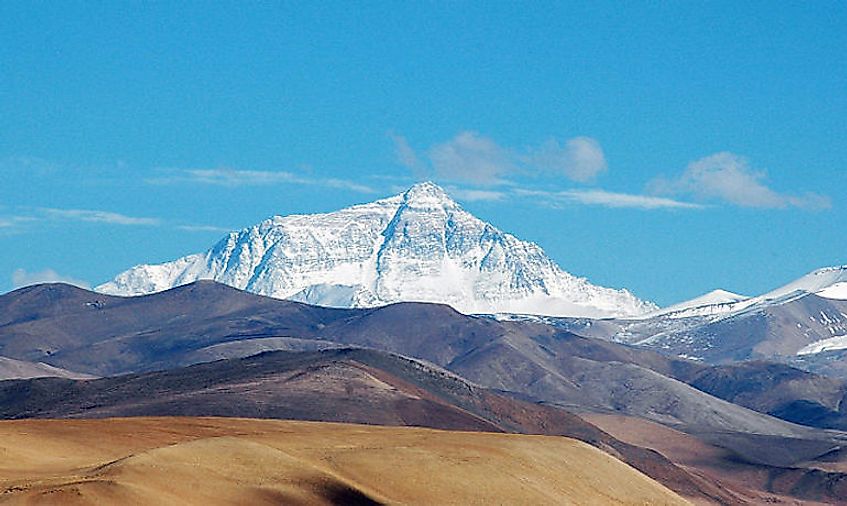Tallest Mountains In Nepal

Everest is world’s tallest mountain and more than half of the earth’s 8,000 + meter mountains are in Nepal, wholly or shared with India or China. Nepal has numerous mountains and ranges including the notable Himalayan ranges. These mountains have contributed significantly to the unique ecosystem present in Nepal and other countries within the region.
Mount Everest
Nepal is home to Mt. Everest, the highest mountain in the world at an elevation of 29,029 feet. The mountain lies on the border of Nepal and Tibet, and it is part of the greater Himalayan ranges. The first measurement of the mountain’s height was recorded in 1856, but it was inaccurate due to Nepal’s refusal to let foreigners in the country. The accepted height was registered in 1955 by an Indian survey and confirmed in 1975 by Chinese measurements.
The Tibetans had regarded the mountain as holy for centuries, attributing it the title of ‘Holy Mother’ or Chomolungma. The mountain was first climbed on May 29, 1953, by two climbers from New Zealand and Nepal. The mountain supports a range of fauna in the lower elevations such as the Himalayan tahr, snow leopard, musk deer, and more than 100 bird species. Snow prevents flora and fauna to thrive over 20,000 feet except for the Himalayan jumping spider, whose presence has been observed by climbers along with few birds. The mountain is part of the Sagarmatha National Park.
Since exploration began on the mountain, it has been subjected to pollution, mainly the litter used by climbers and tourist. The Nepalese government has put up measures to combat the situation, by placing trash bins along the climbing routes to the mountain and requiring climbers to return from climbing with all of their equipment. Climbing Mt. Everest is highly regulated, because of the risks involved such as altitude sickness and snow storms.
Mount Kanchenjunga
Kanchenjunga Mountain is the second highest mountain in Nepal, at an elevation of 28,169 feet. The mountain is located on the border of Nepal and Sikkim, India. Kanchenjunga is the third highest mountain in the world and is part of the greater Himalayan ranges. The name Kanchenjunga means ‘five treasure houses of snow’ an ode to its five peaks. The five treasures are: gold, silver, precious stones, grain, and sacred books according to the native myth.
The first successful ascent was by two British climbers, George Band and Joe Brown in 1955, who had to stop a few meters before the summit, to respect the local tradition which claims that the mountain is holy, and its peak is unconquerable. The mountain is, however, difficult to climb and often results in fatal accidents. A range of flora and fauna thrives on the lower elevations, most of which has been conserved in the Kanchenjunga Conservation Area. Fauna includes the snow leopard, Bengal tiger, Himalayan black bear, red panda, Himalayan musk deer and Himalayan tahr. Settlements on the foot of the mountain have led to deforestation and land transformation, which in turn has caused rapid glacial melting on the mountain and led to flooding.
Mount Lhotse
Lhotse Mountain is the third highest mountain in Nepal at an elevation of 27,940 feet. The mountain holds the title of the fourth highest mountain in the world. The first successful expedition to the mountain was made by two Swiss climbers, Ernest Reiss and Fritz Luchsinger. The mountain is on the border of Nepal and Tibet. Lhotse is sometimes mistaken for a peak on the Everest, due to the proximity of the two mountain giants. Lhotse is notably known for its south face which elevates to 3.2 km in a 2.25 horizontal distance, rendering it the steepest global face of this size. The mountain is steep and poses a potentially dangerous ascend for mountaineers.
Mount Makalu
Makalu Mountain has a height of 27,766 feet and is the fourth largest mountain in Nepal and the fifth tallest mountain in the world. The mountain is part of the Mahalangur Himalayas and is situated on the border with China. At the mountain's base is a unique valley ecosystem, conserved in the Makalu-Barun National Park. Enclosed in the park are about 3,128 different species of flowering plants, over 80 species of mammals and nearly 440 species of birds. Animals include the Asian golden cat, snow leopard and the red panda. The first successful ascent was made in 1955. The mountain is not often climbed, and it is regarded as one of the most challenging mountains to conquer. The Chomo Lonzo peak is at 25,650 feet is a subsidiary summit of Mt. Makalu.
Other tall mountains in Nepal by size in feet are Cho Oyu (26,906), Dhaulagiri I (26,795), Manaslu (26,759), Annapurna I (26,545), Gyachung Kang (26,089) and Annapurna II (26,040). The mountains of Nepal have largely contributed to Nepal’s position as a major tourist destination in the world. The Nepalese government has scaled up efforts to protect the mountains’ biodiversity and promote sustainable Eco-tourism.
Tallest Mountains In Nepal
| Rank | Tallest Mountains in Nepal | Elevation |
|---|---|---|
| 1 | Everest | 29,029 |
| 2 | Kanchenjunga | 28,169 |
| 3 | Lhotse | 27,940 |
| 4 | Makalu | 27,766 |
| 5 | Cho Oyu | 26,906 |
| 6 | Dhaulagiri I | 26,795 |
| 7 | Manaslu | 26,759 |
| 8 | Annapurna I | 26,545 |
| 9 | Gyachung Kang | 26,089 |
| 10 | Annapurna II | 26,040 |











